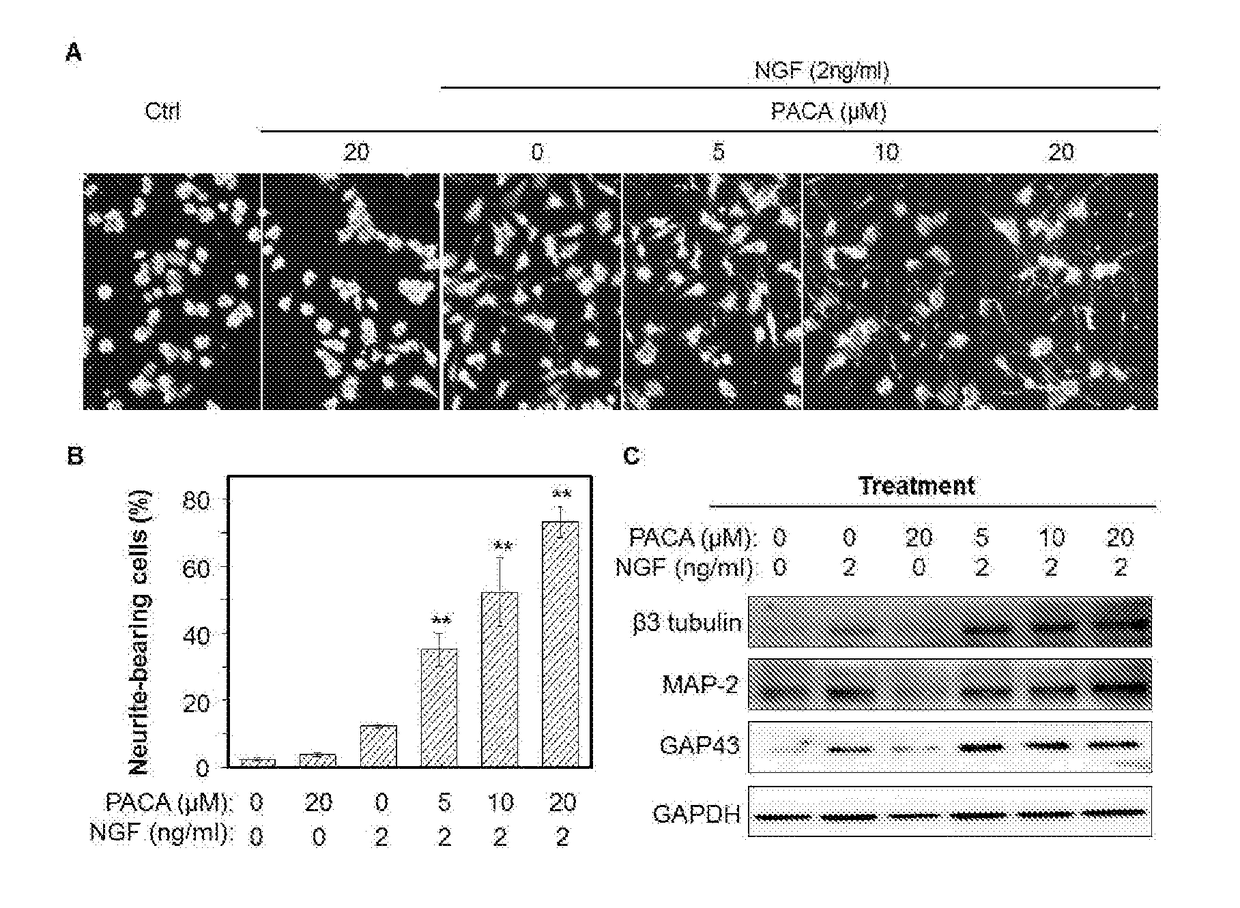A Novel Neuroprotective and Neurorestorative N-Propargyl Caffeamide (PACA) and Use as A Treatment for Neurodegenerative Diseases
a neuroprotective and neurorestorative technology, applied in the separation/purification of carboxylic acid amide, drug composition, peptide/protein ingredient, etc., can solve the problems of pd, ngf and several other neurotrophic factors clinical applications have been dampened, and the neuroprotective effect of npropargyl caffeamide has not been investigated. , the effect of neuroprotection and neuritogenesis
- Summary
- Abstract
- Description
- Claims
- Application Information
AI Technical Summary
Benefits of technology
Problems solved by technology
Method used
Image
Examples
example 1
and Chemical Characterization of PACA
[0043]PACA was synthesized from caffeic acid and propargylamine through four steps, including acetylation, activation of carboxylic acid group, amination and deacetylation. In practical, caffeic acid (0.5 g) was acetylated by acetic anhydride (1 mL) in anhydrous pyridine (2 mL) at room temperature overnight to yield di-O-Ac-caffeic acid (579 mg, ˜90%). Di-O-Ac-caffeic acid was converted into di-O-Ac-caffeic acid N-hydroxysuccinimide ester via reacting with N, N′-disuccinimidyl carbonate (1.28 g) in N, N-dimethylformamide (2 mL). Following the removal of solvents by rotatory evaporation under reduced pressure, the residues containing di-O-Ac-caffeic acid N-hydroxysuccinimide ester were treated with propargylamine (320 μL, 275 mg) at room temperature for 8 hours. The reaction mixture was treated with 3 equivalent NaOMe / MeOH for 2 hours. After the reaction was completed according to TLC detection, the reaction mixture was purified by gel chromatogra...
example 2
nic Effect of PACA
[0044]The neuritogenic activity of PACA was evaluated in rat dopaminergic PC12 cells. PC12 cells were treated with NGF (2 ng / mL) alone or in combination with PACA at the concentrations of 5, 10, 20 μM for 72 hours. The cells were stained by a neurite outgrowth kit, and subsequently analyzed for neurites (>20 μm) under a fluorescence microscope. Compared with NGF alone, PACA significantly potentiated NGF-induced neurite outgrowth in a concentration-dependent manner. PACA (20 μM) alone did not induce neurite outgrowth. Interestingly, PACA (20 μM) and NGF (2 ng / mL) in combination increased the number of neurite-bearing cells by approximate 6-fold relative to NGF alone. Following the treatment with PACA and NGF, alone or in combination, PC12 cells were analyzed by Western blotting for the expression of neuronal biomarkers (i.g., β3-tubulin, MAP2 and GAP-43). Based on the induction of neuronal markers including β3-tubulin, MAP2 and GAP-43, PACA enhanced the neuritogenic...
example 3
ective Effect of PACA
[0045]Neurotoxin 6-hydroxydopamine (6-OHDA) is widely used to induce the cell model of human Parkinsonism. PC12 cells were treated with 6-OHDA with or without PACA for 24-hours, the cell viability was assessed by the colorimetric MTT assay. The relative cell viability was plotted against the concentrations of PACA. On the other hand, primary midbrain neurons were isolated from 17-day-old Sprague Dawley (SD) rat embryos. The midbrain neurons were treated with 6-OHDA with or without PACA for 12-hours, the cell viability was assessed by the colorimetric MTT assay. Alternatively, the neurons were stained with 5 μM of Hoechst 33342 and 1 μM of PI in the differentiation medium at 37° C. for 30 minutes. The images were captured on a Zeiss fluorescence microscope.
PUM
| Property | Measurement | Unit |
|---|---|---|
| Time | aaaaa | aaaaa |
Abstract
Description
Claims
Application Information
 Login to View More
Login to View More - R&D
- Intellectual Property
- Life Sciences
- Materials
- Tech Scout
- Unparalleled Data Quality
- Higher Quality Content
- 60% Fewer Hallucinations
Browse by: Latest US Patents, China's latest patents, Technical Efficacy Thesaurus, Application Domain, Technology Topic, Popular Technical Reports.
© 2025 PatSnap. All rights reserved.Legal|Privacy policy|Modern Slavery Act Transparency Statement|Sitemap|About US| Contact US: help@patsnap.com



